Alaska’s Nonpoint Source Water Quality Program Annual Highlights 2017
December 2017
Table of Contents
- Improving Water Quality in Haines
- Mapping Cottonwood Creek Stormwater
- Cuddy Park Water Quality Success
- Hawk Inlet Waterbody Recovery Plan
- Alaska Clean Harbors and Clean Boating
- Integrated Report Upcoming Changes
- Willow Creek Assessment
- ACWA Grants--A Year of Change
- Resources
- Contacts
Improving Water Quality at the Fort Seward Parade Grounds in Haines, AK
By Gretchen Augat
The Fort Seward Parade Grounds is used for important community activities in Haines, but is also used for city snow storage during the winter months. The melt water from these snow piles often contains pollutants such as oil, sand, antifreeze, hydrocarbons, and metals that can pollute local waterways.
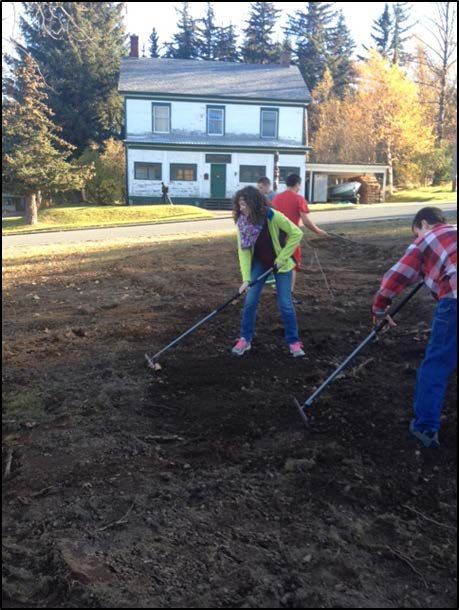
Volunteers help construct the bioswale at the Fort Seward Parade Grounds in Haines, AK. The bioswale is designed to capture and clean up polluted runoff water before it reaches nearby waterways.
To reduce the polluted runoff, DEC partnered with the Takshanuk Watershed Council (TWC) . Using DEC Alaska Clean Water Action (ACWA) grant funds, TWC designed and installed two 700 foot bioswales in the Fort Seward Parade Grounds.
What is a bioswale ? It is a green alternative to the typical pipes and concrete ditches found in residential and commercial areas. B ioswales are landscaped shallow troughs containing natural materials, such as native plants, rocks and soil. Bioswales allow runoff water to slowly infiltrate and get cleaned up by removing a majority of pollutants.
The two new bioswales in the Parade Grounds now capture and treat the snow melt water before it travels to Portage Cove. Plus they look nice with f lowering plants in the summer! The cleaner water entering the cove will prov ide a healthier habitat for the salmon and other marine life.
The Haines Middle and High School students were part of the project by designing an educational sign at the site (shown below). The students also helped plant the native vegetation on the bioswales. To better understand how stormwater flows in Haines, the high school students mapped stormdrains within the Fort Seward area. Additionally, the participating students and several community members joined in the Haines Rain Garden and Bioswale Tour hosted by the Takshanuk Watershed Council in June 2017.
The DEC Nonpoint Source program is pleased to be a part of protecting and improving water quality in Haines and helping the community better deal with runoff pollution.
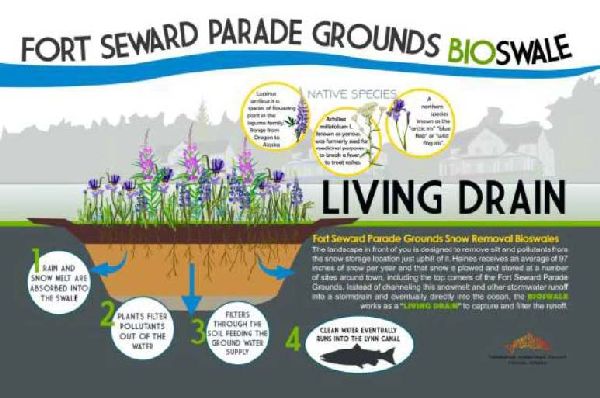
Bioswale educational sign designed by Haines Middle and High School students. The new sign is installed at the Fort Seward Parade Grounds in Haines, AK.
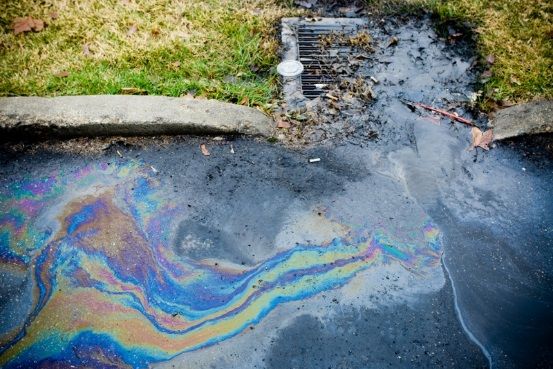
Did You Know?
Polluted runoff occurs when rain or snow melt moving across the land picks up contaminants such as sediment, bacteria or metals and deposits them into local streams, lakes, wetlands and coastal waters.
This type of water pollution is called nonpoint source (NPS). DEC’s NPS Section works state-wide to reduce nonpoint source water pollution.
Cottonwood Creek Stormwater Mapping Completed (Mat-Su)
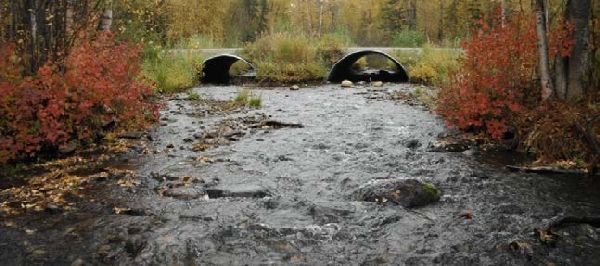
Cottonwood Creek as it flows under Surrey Road in the greater Wasilla area.
By Laura Eldred
Cottonwood Creek, which flows through the greater Wasilla area, is polluted with fecal coliform bacteria and has increased metals carried through runoff water (stormwater) from rain or snow melt. Runoff water becomes polluted as it drains from hard surfaces such as parking lots, roads and roof tops picking up pollutants along its way. I nstead of soaking into the ground and be ing filtered by the plants, it drains into area waterways including Cottonwood Creek. Decreasing the amount of polluted runoff entering Cottonwood Creek is necessary to protect water quality and fish habitat.
Using funding from a 2-year DEC ACWA grant , the Matanuska-Susitna Borough conducted a stormwater infrustructure inventory of the Cottonwood Creek watershed. The inventory included surveying and mapping of stormwater pipes, ditches and stormwater outfalls; determining areas of stormwater runoff into the creek; and estimating stormwater flow rates and drainage areas. The project identified seven (7) areas with inadequate stormwater controls and provided recommendations for correcting these problem drainage areas while incorporating green infrastructure techniques.
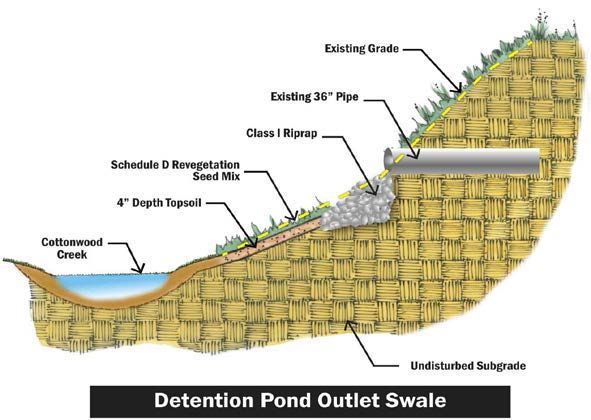
Example of a stormwater retrofit conceptual design to improve Cottonwood Creek’s water quality. Currently the stormwater is discharging from a detention basin and running down the steep slope carrying pollutants directly into the creek. The conceptual design slows the dirty stormwater discharge down, allows it to infiltrate into the rocks and get cleaned up by the vegetation before reaching the creek.
Additionally, observations made during on-the-ground mapping identified locations where culverts and ditches are overgrown, blocked, or have noticeable sediment accumulation that may be obstructing drainage. This lack of maintenance is likely another area negatively affecting water quality. Maintenance of current stormwater treatments is necessary for proper function. The final project report includes several recommendations for ongoing maintenance of existing stormwater infrastructure.
Present ations were delivered to the Matanuska-Suitna Borough Planning Commission and to the Borough Assembly on ways to improve stormwater control by using green infrastructure techniques. Understanding the way stormwater runs across the landscape will help agenc ies and local decision-makers better manage this runoff with the goal of improving Cottonwood Creek’s water quality. Read the final project report.
Cuddy Family Midtown Park – a Water Quality Success (Anchorage)

Municipality of Anchorage city bus sign that was part of the public outreach campaign.
By Jeanne Swartz
By late summer 2015, Anchorage’s Cuddy Family Midtown Park (Cuddy Park) was a mess. Cuddy Park is a fifteen acre green space with three ponds located in the heart of Anchorage.
Wild waterfowl, primarily mallard ducks and Canada geese, are attracted to the green grass and water features at Cuddy Park. Waterfowl populations were exploding; largely because increasing numbers of Cuddy Park visitors were feeding human food to the birds. The food provided by park visitors made it too easy for the birds to stay.

Cuddy Park main pond, September 2015 – before outreach and vegetation installation.
Feces from the birds contaminated the ponds and littered the sidewalks. Water quality samples in the main pond found fecal coliform bacteria levels significantly over state allowed limits.
DEC knew that a successful solution to the fecal coliform pollution problem would require assistance from partners. Using ACWA grant funding, DEC partnered with the Anchorage Waterways Council (AWC) to conduct an outreach program to educate Anchor age residents about the problems with feeding waterfowl. The outreach effort included designing educational and eye-catching signs about the hazards of feeding waterfowl. Download the 2016 DEC NPS Newsletter (PDF).
It didn’t take long to notice positive results from the outreach campaign including a decrease in the number of bird feeding incidences. Even so, a more direct way to discourage waterfowl from lingering at Cuddy Park was needed. DEC then partnered with the Municipality of Anchorage to plant vegetation and install fencing as a way to separate humans and birds. In the summer of 2016, the Municipality planted 113 trees, 250 shrubs, and 113 Iris plants along the shoreline of the main pond. Additionally, 13,200 square feet of sod and 39 fencing units were installed.

Cuddy Park main pond, August 2016 – after outreach and vegetation installation.
The educational signs and the vegetation barrier had a remarkable effect. Ducks and geese still stopped at Cuddy Park, but, deprived of easy access to human handouts, they only stayed a short time. This greatly reduced the fecal pollution problem. By May of 2017, the levels of fecal coliform bacteria declined by 260 percent!
Using DEC ACWA grant funding, AWC conducted a survey among visitors to Cuddy Park to measure outreach message effectiveness. Results from the surveys showed the largest source (over 50%) of information about the problems with people feeding waterfowl came from signs in the park, followed by 20% each from newspaper articles and bus signs. This information will help inform any future outreach efforts.
Thanks to project partners and funding from the DEC ACWA grant program, Cuddy Park visitors can now have a more enjoyable experience without having to scrape their shoes before getting in the car!
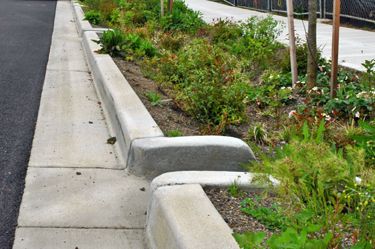
Green infrastructure example with a curb cut-out leading to a stormwater treatment bioswale adjacent to a roadway. The bioswale slows down and cleans the polluted stormwater. This protects the nearby stream and fish habitat.
Did You Know?
Green infrastructure is an approach to water management that protects, restores, or mimics the natural water cycle. Green infrastructure is effective, economical, and enhances community safety and quality of life. The DEC NPS program continues to support green infrastructure in our projects.
Green infrastructure incorporates both the natural environment and engineered systems to provide clean water, conserve ecosystem values and functions, and provide a wide array of benefits to people and wildlife.
Green infrastructure solutions can be applied on different scales, from the house or building level, to the broader landscape level. Learn more at EPA.gov
Hawk Inlet Waterbody Recovery Plan (Southeast)
By Gretchen Augat
DEC’s NPS program helped develop a waterbody recovery plan for Hawk Inlet, located on northern Admiralty Island in southeast Alaska. The recovery plan summarizes years of water quality data in Hawk Inlet, and provides recommendations to address metal-contaminated marine sediments at the Greens Creek Mine Loading Dock and an area in the north end of Hawk Inlet.
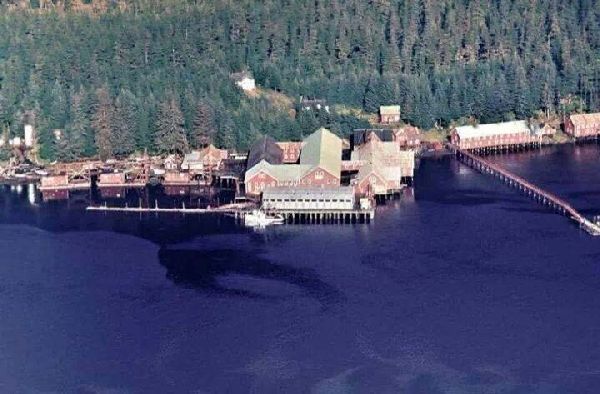
Cannery located in Hawk Inlet and associated industrial support facilities, prior to burning down in the 1970s.
Five metals (cadmium, copper, lead, mercury and zinc) are above the screening benchmark levels recommended by the National Oceanic and Atmospheric Administration for marine sediment in two areas of Hawk Inlet. The mine loading dock was contaminated by an ore concentrate spill in 1989. Cleanup actions occurred in 1994 but were complicated by debris from a 1974 cannery fire leaving pockets of ore concentrate in various locations. Additionally, increased metal concentrations were found near the northern end of Hawk Inlet. The exact source of these metals is unknown.
The waterbody recovery plan notes that recent marine sediment sampling data at the mine loading dock indicate that the historic ore concentrate spill residual levels are slowly decreasing. The recovery plan calls for relying on natural sedimentation processes to restore the marine sediments and on controlling existing or any future inputs from causing additional marine sediment pollution. Sample collection and testing of cadmium, copper, lead, mercury, and zinc in the sediment, water column, and tissue are also recommended. Results of the sampling will help identify and delineate area(s) where targeted sediment removal might be feasible if needed.
DEC is committed to tracking the continued recovery of Hawk Inlet and to protecting human health and the environment.
Alaska Clean Harbors & Clean Boating Activities

By Chandra McGee and Laura Eldred
With over 14% of Alaska’s total area being water and having 45,000 miles of coastal marine shoreline, it’s no wonder Alaskans are on the water a lot—to fish, as transportation highways, and to recreate. Preventing or reducing water pollution from motorized watercraft and keeping Alaska’s harbors clean is important for all Alaskans to consider. DEC’s NPS program works with several partners around the state on clean boating education and the Alaska Clean Harbors program
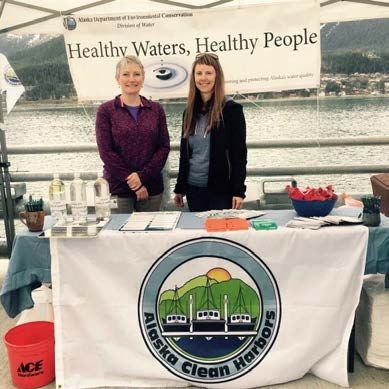
Alaska Clean Harbors outreach booth encouraging the use of marina sewage pump-out stations. Pictured are NPS program staff Gretchen Augat and Chandra McGee.
Since 2010, Alaska Clean Harbors has worked with Harbormasters around Alaska to prevent pollution through the implementation of common sense best management practices. This year had a particular focus encouraging the use of sewage pump-out stations in harbors.
The project educated boaters and harbormasters on the importance of proper sewage management, obtained feedback on barriers to pump-out use, and encouraged harbormasters statewide to apply for funding to improve harbor sewage management facilities.
The project developed a workshop outline including a presentation, demonstration videos, educational materials and a pump-out kit. The pump-out kits were handed out to interested boaters at outreach events.
Clean boating tips were also shared at popular sport fishing and other recreational areas in southcentral Alaska. Radio ads encouraged boaters to help keep petroleum products out of local waterways. Nearly 1,500 clean boating kits were handed out .
More information about Alaska Clean Harbors can be found at the website AlaskaCleanHarbors.org and clean boating information at BoatUs.org. If we all work together, we can help keep Alaska’s waterways clean!
Did You Know?
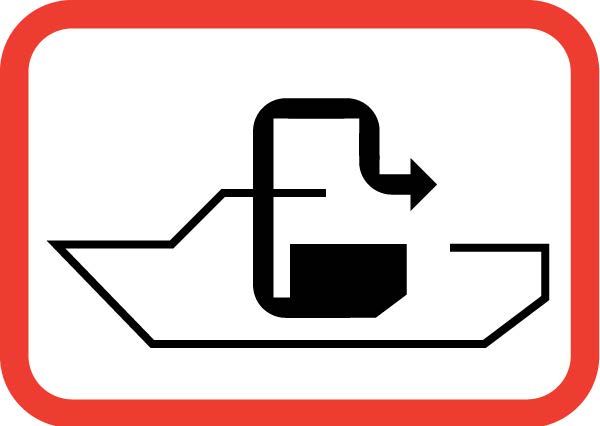
Look for this symbol to locate the sewage pump-out station in the harbor. Keep our harbors clean and use pump-outs. Pump, Don’t Dump!
Upcoming Changes to the 2018 Integrated Report
By Drew Grant
In January 2017, DEC Nonpoint Source program conducted a critical review of Alaska’s Integrated Report process to improve the timeliness of submittals and incorporate the Environmental Protection Agency’s (EPA) redesigned reporting system known as ATTAINS (Assessment and Total Maximum Daily Load Tracking and Implementation System). The Integrated Report contains information that is required under the federal Clean Water Act on the health of Alaska’s waters. EPA then combines all the information provided by states and reports to Congress.
As part of this review the DEC’s NPS program co nducted what is known as a “Lean/Kaizen event” to review and improve the Integrated Report and the Report process. Lean government helps improve the speed and quality of processes by eliminating wastes such as document errors, unnecessary process steps, and waiting time. The goals of the Integrated Report Lean event were:
- Issue the Integrated Report on–time
- Remove extraneous/duplicative information
- Streamline tough technical decisions
- Satisfy the customers’ needs: DEC management, EPA, & users of the decisions (permitting groups, other agencies, other stakeholders).
The LEAN exercise resulted in some significant changes on how the Integrated Report is developed. Among other changes, DEC will use greater reliance on technology to streamline the report. Starting in 2018, Alaska’s Integrated Report to the EPA will be an electronic submittal using the ATTAINS data system. EPA and the public will also have access to ATTAINS for viewing water quality information submitted by states. Find more information on the Integrated Report process.

Example of how DEC nonpoint source program staff used a Lean process to re-map the Integrated Report process for increased efficiency and to follow a 2 year cycle.
Willow Creek Water Quality Monitoring (Mat-Su)
By Laura Eldred

Willow Creek is an important and popular salmon and rainbow trout stream in southcentral Alaska.
Assessing water quality in streams and lakes that may be polluted is an important part of the NPS program’s work. Willow Creek, in the Matanuska-Susitna Borough, was the focus of a 2-year water quality assessment in 2015 and 2016. The first year of the study also included an aquatic habitat assessment with results available on the DEC reports webpage listed below.
Willow Creek is an important and popular salmon and rainbow trout stream. Possible threats to healthy water quality and aquatic habitat in Willow Creek include increasing shoreline development, recent flood events, increased bank erosion, and historic and current mining activities within the watershed.
Water samples were collected from four Willow Creek monitoring locations during May, July, August and September 2016 to represent different river flow conditions. Laboratory analysis for dissolved metals concentrations, macronutrients, alkalinity, hardness, and fecal coliform bacteria was conducted; also instream field tests for pH, specific conductivity, dissolved oxygen, turbidity and temperature were measured. Microbial source tracking analysis was conducted to help identify bacteria sources.
Willow Creek water quality met all state water quality criteria except for fecal coliform bacteria downstream of the Parks Highway. Microbial source tracking on these bacteria samples indicated no evidence of ongoing bacteria pollution from human sources.
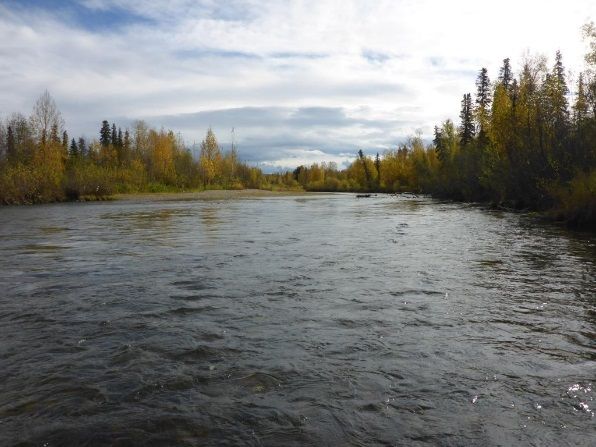
Willow Creek water quality is in good condition but keeping it that way for years to come may require attention.
Microbial source tracking is a set of methods used to determine the host (different animals or human) that contributes fecal pollution to a waterway. Variations in DNA sequences between living organisms makes it possible to distinguish between these organisms through molecular biology techniques. This study examined human, dog, and horse microbial sources.
Recommendations are to keep Willow Creek water quality from degrading. This can be done through land use management, education, and implementing best management practices for construction and mining operations.
The water quality reports detailing the study results for both years are available on the NPS reports web page.
Alaska Clean Water Action (ACWA) Grants – A Year of Change
By Cindy Gilder
This year, DEC Nonpoint Source Program decided to change the award cycle for Alaska Clean Water Action (ACWA) grants. DEC is also investigating additional ways to streamline the grant process. Our goal is to reduce the burden both on state resources and the potential grantees.
For over 20 years, ACWA grant funding has allowed multiple organizations and communities throughout Alaska to address nonpoint source pollution through prevention, stewardship and direct restoration projects.
Since 2002 DEC has issued ACWA g rants in partnership with the Dep artments of Fish and Game (ADF&G) and Natural Resources (DNR). Funding for the grants has come from a range of programs, including the ADF&G’s sustainable salmon funds and DNR’s Coastal Zone Management program. The past few years, DEC has provided the vast majority of the monies using federal dollars provided through the Clean Water Act Section 319 program administered through the Environmental Protection Agency (EPA). Unfortunately, the President’s budget for the EPA did not provide continued funding for t he program. This resulted in DEC delaying issuing any ACWA grants in July 2017, as would normally have occurred, until funding becomes more assured.
As a result of the funding uncertainty, DEC decided to use the opportunity to adjust the grant cycle to be able to completely fund projects which require field work in to one grant year. DEC plans on issuing grants in March of 2018 for applicants that applied in February 2017. This will mean the next request for proposals will occur in October 2018, followed by successful proposals being announced in December 2018 for a project start date of March 2019 . In summary, the new ACWA grant year will run March 1 through February 28. Keep an eye on the ACWA webpage listed below for additional information.
These projects have been funded wholly or in part by the United States Environmental Protection Agency under assistance agreement BG-00J84603 to the Alaska Department of Environmental Conservation. The contents of this document do not necessarily reflect the views and policies of the Environmental Protection Agency, nor does mention of trade names or commercial products constitute endorsement or recommendation for use.
Resources
Nonpoint Source Water Quality Staff Contacts
- Laura Eldred
- Statewide Section Manager
- 907-376-1855
- Gretchen Augat
- Southeast and BEACH
- 907-465-5023

 Indicates an external site.
Indicates an external site.